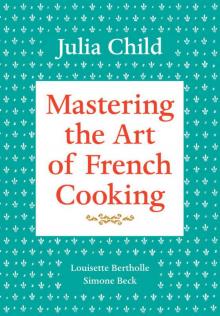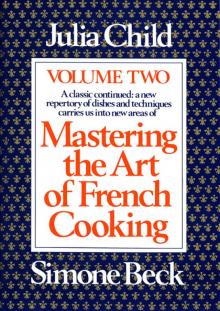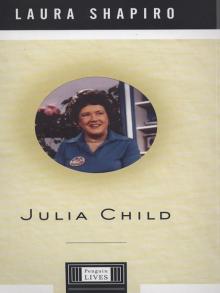- Home
- Julia Child
Mastering the Art of French Cooking, Volume 1 Page 23
Mastering the Art of French Cooking, Volume 1 Read online
Page 23
These featherweight wafers are often made of Swiss cheese, but you can use other cheese or a mixture of cheeses if you wish, and thus employ leftovers. The dough contains just enough flour to hold the galettes together while they bake, and ¾ cup of flour is usually right for Swiss cheese. You will probably need more if you are using soft cheeses, and should always bake one as a test.
For about 30 wafers
Preheat oven to 425 degrees.
½ lb. (about 2 pressed-down cups) grated Swiss cheese or a mixture of cheeses
½ lb. softened butter
½ cup all-purpose flour, more if needed
¼ tsp pepper
Pinch of cayenne pepper
Salt to taste
Knead all ingredients together in a bowl or on a board. The mixture will be sticky. Roll a 1-tablespoon bit into a ball in the palms of your hands, then flatten it into a cake ¼ inch thick. Bake 10 to 15 minutes in hot oven to observe how it holds together; it should spread slightly, puff lightly, and brown. If it spreads out more than you wish, or is too fragile, knead in ¼ cup more flour and make another test.
Lightly buttered baking sheets
1 egg beaten with ½ tsp water in a small bowl
A pastry brush
½ cup grated Swiss cheese
A cooling rack
When you are satisfied, form the rest of the dough into cakes and place on baking sheets. Paint the tops with beaten egg and top each with a pinch of grated cheese. Bake for 10 to 15 minutes until the galettes have puffed, and browned lightly. Cool them on a rack.
Galettes au Roquefort
[Roquefort Cheese Biscuits]
The dough for these galettes may also serve as a pastry dough for tarts and turnovers.
For about 30 biscuits
¼ lb. Roquefort or blue cheese
A 2-quart mixing bowl
¼ lb. softened butter
2 Tb whipping cream
1 egg yolk
¾ cup flour (scooped and leveled)
Mash the cheese in the bowl with a mixing fork. Beat in the butter, cream, and egg yolk. Then knead in the flour. Form into a ball, wrap in waxed paper, and chill until firm. Roll out ¼ inch thick, cut into 1½-inch rounds, brush with egg, and bake as in the preceding recipe.
Galettes au Camembert
[Camembert Biscuits]
This dough may substitute for the usual pastry dough for tarts and turnovers.
For about 50 biscuits
6 to 8 ounces ripe Camembert, Brie, or Liederkranz cheese
A 2-quart mixing bowl
3 ounces (¾ stick) softened butter
2 eggs
½ tsp salt
⅛ tsp pepper
Pinch of cayenne pepper
2 cups sifted all-purpose flour
Scrape off the crusts and mash the cheese in the bowl with a mixing fork. Blend in the butter, then beat in the eggs and seasoning. Work in the flour and knead everything together for a moment to make a smooth and fairly supple dough. Knead in a tablespoon or so more flour if dough seems too soft. Wrap in waxed paper and chill until firm. Roll out ¼ inch thick, cut into 1½-inch rounds, and brush with egg as in the preceding master recipe for cheese biscuits. Bake in upper third of a preheated 350-degree oven for about 15 minutes, or until lightly browned.
BOUCHÉES PARMENTIER AU FROMAGE
[Potato Cheese Sticks]
Mashed potato gives these little cheese mouthfuls a nice, tender quality.
For about 60 pieces
½ lb. baking potatoes (2 medium potatoes)
Peel and quarter the potatoes. Boil in salted water until tender. Drain, and put through a ricer. You should have 1 cup.
Stir the potatoes over moderate heat in a heavy-bottomed saucepan for 2 to 3 minutes until they form a light film on the bottom of the pan, indicating most of their moisture has been evaporated.
⅔ cup flour (scooped and leveled)
4 ounces (1 stick) softened butter
1 egg
4 ounces (1 cup) grated Swiss cheese
⅕ tsp white pepper
Pinch of nutmeg
Pinch of cayenne pepper
Salt as needed
Beat the flour into the potatoes, then the butter by fractions, then the egg, cheese, and seasonings. Taste for seasoning. Preheat oven to 425 degrees.
2 lightly buttered baking sheets
With a fluted pastry tube ¼ inch diameter, squeeze the mixture into 2½-inch lengths spaced ½ inch apart onto the baking sheets.
Bake both sheets at a time in preheated oven for about 15 minutes, or until sticks are lightly browned.
CANAPÉS, BREAD CASES, AND TARTLET SHELLS
Although Melba toast and crackers make good foundations for hot appetizers, the following are more elegant. They may be used interchangeably, all of them may be prepared ahead, and they may also be filled and browned, then reheated. When bread is specified, use only a homemade type of white bread with body, not the soft squashy type. French recipes call for pain de mie.
Canapés — Croûtons
[Plain or Sautéed Bread Rounds]
Plain, sliced, white bread works perfectly well for canapés when cut into triangles or rounds, spread with a filling, then set in a preheated 425-degree oven until the bread is toasted on the bottom and the filling has puffed and browned on top. But if you wish to be more elaborate, proceed as follows:
Slice the bread ¼ inch thick, and cut it into rounds 1½ to 2 inches in diameter with a fluted cutter. Heat ⅛ inch of clarified butter in a skillet and sauté the rounds on each side until very lightly browned, adding more butter as necessary. (These are called croûtons when they are triangular and garnish an entrée.)
Heap the filling (recipes are on following pages) upon each canapé in a ½-inch dome. Top with a pinch of grated cheese, and a drop of melted butter. Arrange on a baking sheet and slip for a moment under a hot broiler to brown the tops lightly. If prepared in advance, reheat in a 350-degree oven for several minutes.
Croûtes
[Toasted Bread Cases]
Slice off the crust. Cut the bread into 1-inch slices, and the slices either into 1-inch cubes or, with a cutter, into rounds. Cut out a well in the center of each. Tamp down the bread on the sides and bottom of the well with your finger to make an open-topped case about ¼ inch thick. Paint the tops and sides with melted butter. Place on a baking sheet and brown lightly for 5 minutes in the upper third of a preheated 450-degree oven.
Place filling in the hollow centers. Top with a pinch of grated cheese and a drop of melted butter. Brown top of filling delicately under a hot broiler for a moment. Reheat, if they have been prepared in advance, in a 350-degree oven for several minutes.
Tartelettes
[Little Pastry Shells]
Following the general procedure for pastry dough, and for pastry shells, roll the dough a bit less than ⅛ inch thick. Line buttered pastry molds ½ inch deep and 2 to 2½ inches in diameter, or shallow muffin tins, with the dough. Flute the rims with the back of a knife. Prick the bottom of the dough with a fork. Fill each mold or cup with a round of buttered brown paper and a small handful of dried beans; or set another mold on the pastry. Either will keep the bottom from puffing up and the sides from collapsing. Bake in a preheated 400-degree oven for 7 to 8 minutes, or until pastry will hold its shape. Remove paper and beans or empty molds. Prick bottom of shells again and return to oven for 2 to 3 minutes more, or until shells are just beginning to color and to shrink from sides of molds. Remove shells and cool on a rack.
Place a filling (following) in center. Top with a pinch of cheese and a drop of melted butter. Arrange on a baking sheet and set in a 450-degree oven for 5 minutes or so, until filling has browned on top. If done ahead, reheat in a 350-degree oven for several minutes.
SPREADS AND FILLINGS
Farces
Use these multipurpose cream fillings for the sautéed bread rounds, bread cases or tartelettes. They may also garnish the cream puffs, the pastry turnovers,
the croquettes, and the crêpes.
FONDUE AU GRUYÈRE
[Cream Filling with Swiss Cheese]
For about 2 cups
2½ Tb butter
3 Tb flour
A 2-quart saucepan
A wire whip
1½ cups boiling milk or boiling light cream
½ tsp salt
⅛ tsp pepper
Pinch of nutmeg
Pinch of cayenne pepper
Cook the butter and flour slowly together in the saucepan for 2 minutes without coloring. Off heat, beat in the boiling milk or cream, then the seasonings. Boil, stirring, for 1 minute. Sauce should be very thick. Taste for seasoning.
1 egg yolk
4 ounces (1 cup) coarsely grated Swiss, or Swiss and Parmesan, cheese
2 Tb butter
Remove sauce from heat. Place egg yolk in center of sauce and immediately beat it vigorously in with the wire whip. Beat for a moment to cool slightly, then beat in the cheese, and finally the butter. Taste carefully for seasoning. If not used immediately, dot top of sauce with butter to prevent a skin from forming.
VARIATIONS
Garlic and Wine Flavoring
½ Tb butter
1½ Tb minced shallots or green onions
1 small clove mashed garlic
½ cup dry white vermouth
Using a small enameled saucepan, cook the shallots or onions, and garlic slowly in butter for a moment. Add wine, raise heat, and boil down rapidly until wine is reduced to ¼ cup- Substitute this for ¼ cup of milk in the master recipe.
Ham
½ cup minced ham or Canadian bacon
½ Tb butter
Sauté the ham for a moment in butter. Substitute it for half of the cheese in the master recipe.
Mushrooms or Chicken Livers
¼ lb. diced mushrooms or chicken livers
1 Tb butter
Salt and pepper
Sauté the mushrooms or chicken livers in the butter. Season to taste, and substitute for half of the cheese in the master recipe.
FONDUE DE CRUSTACÉS
[Cream Filling with Shellfish or Clams]
For about 2 cups
½ Tb minced shallots or green onions
2 Tb butter
1¼ cups diced or flaked, cooked or canned shellfish; or canned minced clams
⅓ cup dry white wine or dry white vermouth; or
3 to 4 Tb Madeira or sherry
Salt and pepper to taste
Optional: 1 Tb minced fresh herbs such as tarragon or chervil; or ½ tsp dried tarragon or oregano
Using a 2-quart saucepan or a small enameled skillet, cook the shallots or onions in the butter for a moment over low heat. Stir in the shellfish or clams and cook slowly for 2 minutes over low heat. Add the wine. Cover and simmer for 1 minute. Uncover, raise heat, and boil rapidly until liquid has almost evaporated. Season to taste and stir in optional herbs.
2 Tb butter
2½ Tb flour
1 cup boiling liquid (milk, plus—if you have it—concentrated fish stock or mushroom juice, or clam juice)
⅛ tsp pepper
Salt to taste
In a separate 2-quart saucepan, cook the butter and flour slowly together for 2 minutes without coloring. Off heat, beat in the boiling liquid, pepper, and salt to taste. Boil, stirring, for 1 minute.
1 egg yolk
¼ cup whipping cream
Beat egg yolk and cream in a bowl. Remove sauce from heat and beat it into the bowl by tablespoons. Return to saucepan and boil, stirring, for 1 minute. Sauce should be very thick. Correct seasoning.
¼ cup grated Swiss cheese
Fold the previously prepared shellfish, then the cheese into the sauce, and check seasoning again. If not used immediately, dot top of sauce with butter to prevent a skin from forming.
VARIATION
Fondue de Volaille
[Cream Filling with Chicken or Turkey]
Using exactly the same method and proportions as for the preceding fondue de crustacés, substitute 1 cup of diced, cooked chicken, turkey, duck, or game for the shellfish or clams.
CROQUETTES
Crèmes Frites, Fondues, Cromesquis
Any of the preceding fondues, starting may be chilled, cut into squares or balls, rolled in egg and bread crumbs, then browned in deep fat. But as you need a far thicker sauce, here is a different method.
For 24 pieces 1½ inches square and ½ inch thick
½ cup flour (measure by scooping into cup; level off with knife)
1½ cups milk
2 egg yolks
Salt, pepper, and nutmeg
2 Tb butter
1 cup any of the preceding flavorings
1 Tb melted butter
Place flour in a heavy saucepan, gradually blend in milk with a wire whip. Stir over moderate heat until mixture begins to lump. Remove from heat and vigorously blend in egg yolks. When smooth, beat over heat 2 minutes to thicken sauce. Remove from heat; beat in seasonings and butter. When sauce is slightly cool, add flavoring. Spread ½ inch thick in a lightly buttered platter. Film surface with melted butter; cover and chill several hours.
1 cup flour
3 pie plates
1 egg and 2 egg whites beaten with 1 Tb oil, 1 tsp water, salt and pepper
2 cups fine, dry, white bread crumbs
Frying oil and deep-fat frying equipment
Turn the flour in one plate, beaten egg in second, and crumbs in third. Scoop up 1½ tablespoons chilled mixture with a spatula; drop into flour. Dredge lightly and shape into a square with fingers. Drop into egg and spoon it over entire surface. Drain on a fork and drop into crumbs. Pat crumbs evenly over entire surface. (*) Croquettes may be crumbed a day in advance; cover and refrigerate.
Brown 4 to 5 croquettes at a time for 2 to 3 minutes in frying oil at 375 degrees. Drain on crumpled paper towels. Reheat if necessary for 2 to 3 minutes only in a preheated 450-degree oven.
TURNOVERS
Chaussons
PETITS CHAUSSONS AU ROQUEFORT
[Pastry Turnovers with Roquefort Cheese]
These nice little mouthfuls are made of pastry dough rolled out and cut into squares, ovals, or circles. In the center a small lump of filling is placed. The edges of the pastry are moistened with beaten egg, then either another piece of pastry is placed on top, or the original pastry is folded over upon itself to enclose the filling. They are then baked in a hot oven until they puff and brown. In making them, avoid putting in so much filling that the pastry cannot be sealed, and be sure to seal carefully so the turnovers do not burst while baking. A ravioli stamp—a heavy metal ring about 2 inches in diameter with serrated teeth—will seal 2 rounds of pastry most efficiently together.
Turnovers may enclose a variety of stuffings other than Roquefort, such as the cream fillings or any of the liver, sausage, or veal mixtures in the pâté section, or the ground meat mixtures in the Beef, Lamb, or Veal sections. You can also use little pork sausages or store-bought sausage meat. Chaussons may be made in any size or shape, from about 2½ inches for appetizers to 12 inches for an entrée.
For about 40 pieces
½ lb. Roquefort or blue cheese
A 3-quart mixing bowl
¼ lb. (1 stick) softened butter
2 egg yolks
1 to 2 Tb kirsch or cognac
1¼ tsp pepper
2 Tb minced chives or minced green onion tops
Mash the cheese in the bowl with a mixing fork. Beat in the butter, then the egg yolks, kirsch or cognac, pepper, and chives or onion tops.
2 to 6 Tb whipping cream
Beat in the cream by tablespoons but do not let the mixture thin out too much. It should remain a fairly thick paste. Correct seasoning.
Chilled pastry dough made from 4 cups of flour
Roll out the dough into a rectangle ⅛ inch thick. With a ravioli wheel or a knife, cut the dough into 2½-inch squares.
Preheat oven to 425 degrees.
1 egg beaten i
n a bowl with ½ tsp water
A pastry brush
Lightly buttered baking sheets
Place 1 teaspoon of filling in the center of each square. One by one, paint a ¼-inch border of beaten egg around the edges of the pastry. Fold the pastry over on itself into a triangle. Press the edges together firmly with your fingers. Press them again making a design with the tines of a fork. Place on a buttered baking sheet and continue with the rest of the turnovers. Paint the tops with beaten egg. Make shallow Crosshatch lines with the point of a knife, and poke a ⅛-inch hole through the center of each pastry top so cooking steam can escape.
Bake in upper third of preheated oven for about 15 minutes, or until puffed and lightly browned.
Turnovers may be baked, then reheated. Baked turnovers may also be frozen, then set in a 425-degree oven for 5 minutes or so to thaw and heat through.
CHAPTER FIVE

 Julia's Kitchen Wisdom
Julia's Kitchen Wisdom My Life in France
My Life in France Mastering the Art of French Cooking, Volume 1
Mastering the Art of French Cooking, Volume 1 Mastering the Art of French Cooking, Volume 2
Mastering the Art of French Cooking, Volume 2 Laura Shapiro
Laura Shapiro